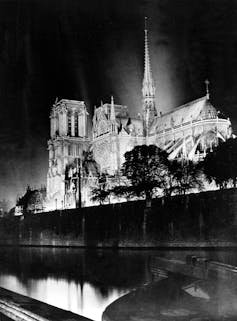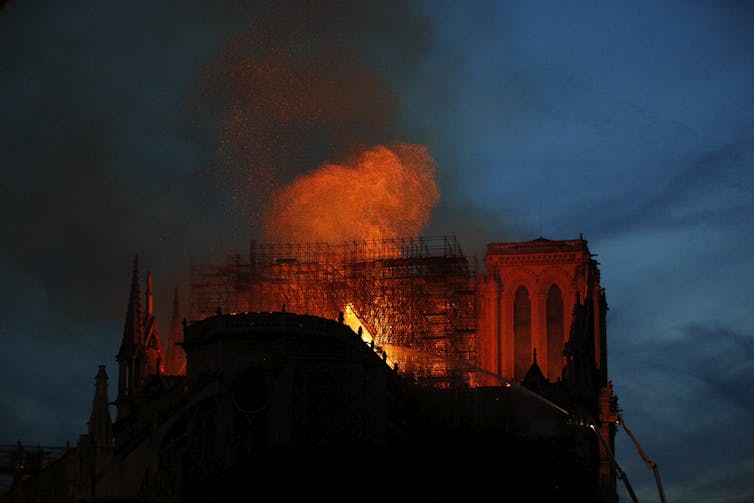Notre Dame has shaped the intellectual life of Paris for eight centuries
- Written by Emily E. Graham, Assistant Professor of Medieval History, Oklahoma State University
The burning wreckage of the 12th-century Notre-Dame de Paris led to an immediate outpouring of grief over the damage to its irreplaceable architecture and works of art.
But as a scholar[1] of medieval religious history, I know that the cathedral has an influence that goes way beyond its physical structure.
Its impact on the city and its people is not just visual, but social, religious and political.
The cathedral and the city
Medieval Paris was a thriving and cosmopolitan city[2] of merchants, beggars, bankers, servants and scholars. Its households were graced with fine tapestries and furnishings, and shops featured luxurious fabrics and furs, maintained by servants[3] requiring the management of a capably trained housekeeper[4].
From the narrow medieval streets, Notre Dame[5]’s towers loomed impossibly large over the small wooden houses below them. The cathedral, its clergy and its square were important to medieval civic life. They hosted markets and solemn private legal and personal ceremonies including engagement ceremonies[6].
Notre Dame’s influence even extended to the prisons of Paris. On Palm Sunday, the cathedral clergy walked in solemn procession from the Abbey of St. Geneviève, a monastery dedicated to the city’s patron saint, to the cathedral. Along the way, they would stop at the door of Châtelet prison, and a single prisoner would be released[7] in honor of the holy day.
On feast days, the relics of local saints were brought in procession through the streets of the city. Pilgrims[8] thronged the cathedral to visit the relics of the Crucifixion[9] held there, providing a boost to the local economy.
Their “votive offerings,” or the gifts they made to the saints to whom they prayed, were often made of wax. Votive candles are lit in a similar spirit today.
The massive 14th-century choir stalls were reserved for the canons[10], a small community of clergy attached to the cathedral. They cared for the cathedral’s vestments, relics and other valuables.
They also organized masses for the dead. The cathedral’s donors often sought to commemorate the anniversary of their loved ones’ deaths, to speed their way toward heaven.
The origins of the university
Paris, famous for its philosophers, artists, poets and composers, owes much to Notre Dame and its influence on the world of the mind.
The cathedral compound where the canons lived also included the cathedral school, where priests of the diocese were trained and where the best European scholars[11] came to study.
Influential medieval thinkers such as Thomas Aquinas[12], Albertus Magnus[13], Erasmus[14], John Calvin[15], several popes and many other intellectual luminaries studied or taught there in its early centuries. The opportunity to study with famous scholars drew students from across Europe.
To capitalize on their presence, in 1200 the savvy king Philip Augustus decreed that all students were under the jurisdiction of the church. In 1215, the pope’s representative in Paris, the papal legate, issued statutes organizing the university’s studies and requirements for teaching. In 1231, a papal bull “Parens Scientarium”[16] gave the university the power to organize its own statutes – and thus, one of the first universities[17] in Europe was born, just across the river from the cathedral.
The first hostel for university students was founded in 1257 by the royal chaplain Robert de Sorbonne, from whom the Sorbonne University in Paris takes its sobriquet today.
Notre Dame’s deep influence over the years
 A nighttime view of the cathedral in 1933.
AP Photo[18]
A nighttime view of the cathedral in 1933.
AP Photo[18]
The university, in turn, shaped the city. Students and masters all required food, drink, lodging and other services. They, along with the many priests and other clergy of the cathedral, local parishes, monasteries, and bishops’ households made up a substantial part of the city’s population and economy.
Because it was created by the decree of a papal representative, the university was governed by the Catholic Church. Students joined the lower end of the clerical hierarchy, and were exempt from punishment by secular authorities.
Like today, there were protests and strikes. In 1229, a massive student protest was held when several students were killed by the city guard. Later clashes included protests over high costs of living – a reminder of “yellow vest” protests in France[19] today.
In recent centuries, many well-known scientists, writers, politicians and scholars studied at the Sorbonne. Many of them have had a great impact on France and on the world. Among them are luminaries such as Marie Curie[20], Simone de Beauvoir[21], Francois Mitterand[22], Norman Mailer[23] and Elie Wiesel[24].
 The cathedral has been much more than its physical structure.
AP Photo/Francois Mori[25]
The cathedral has been much more than its physical structure.
AP Photo/Francois Mori[25]
The focus in news coverage has been, and rightly so, on the physical building: the stone, the stained glass, the timber roof that burned. But as we start to discuss restoration, let us also appreciate the many roles that Notre Dame has always played for the city and its people, as much now as when it was built.
References
- ^ scholar (scholar.google.com)
- ^ thriving and cosmopolitan city (www.upenn.edu)
- ^ maintained by servants (www.upenn.edu)
- ^ capably trained housekeeper (www.cornellpress.cornell.edu)
- ^ Notre Dame (www.brepols.net)
- ^ engagement ceremonies (global.oup.com)
- ^ released (www.editions-sorbonne.fr)
- ^ Pilgrims (www.brepols.net)
- ^ relics of the Crucifixion (fortune.com)
- ^ canons (www.upenn.edu)
- ^ the best European scholars (www.cambridge.org)
- ^ Thomas Aquinas (www.christianitytoday.com)
- ^ Albertus Magnus (www.britannica.com)
- ^ Erasmus (www.iep.utm.edu)
- ^ John Calvin (www.christianitytoday.com)
- ^ “Parens Scientarium” (sourcebooks.fordham.edu)
- ^ universities (www.amazon.com)
- ^ AP Photo (www.apimages.com)
- ^ “yellow vest” protests in France (www.nbcnews.com)
- ^ Marie Curie (www.nobelprize.org)
- ^ Simone de Beauvoir (www.iep.utm.edu)
- ^ Francois Mitterand (www.nytimes.com)
- ^ Norman Mailer (www.newyorker.com)
- ^ Elie Wiesel (www.nobelprize.org)
- ^ AP Photo/Francois Mori (www.apimages.com)
Authors: Emily E. Graham, Assistant Professor of Medieval History, Oklahoma State University

